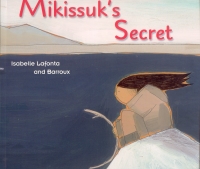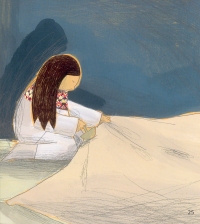| ________________
CM . . .
. Volume XIV Number 18. . . .May 2, 2008 
 |
Mikissuk's Secret.
Isabelle Lafonta. Illustrated by Barroux.
Toronto, ON: Scholastic, 2008.
40 pp., pbk., $6.99.
ISBN 978-0-545-99610-5.
Grades 1-3 / Ages 6-8.
Review by Shari Klassen.
*** ½ /4
|
| |
|

excerpt:
Sorqaq was already up, rubbing the dog's harness with whale oil. Before he set out for his first ride on the new sled, he waved goodbye: "Just you wait, my little snow-star, I'll bring back the finest furs in Nunavut for you!"
Mikissuk didn't wave back. She looked down at her boots. She was tired of being a little snow-star. Maybe she looked as weak as a seal's whisker, but inside she knew she was as strong as a rock.
Why couldn't her brother see that?
"How can I open his eyes?" she sighed.
Then she had an idea.
Mikissuk and her older brother, Sorqaq, have a deep bond. Mikissuk loves her brother as a dear friend and looks up to him for guidance and encouragement, and Sorqaq is her protector. Yet, when Sorqaq leaves on the annual hunt, Mikissuk – a girl of perhaps nine or ten years of age and said to be too small and weak to accompany him – is left at home, alone and discouraged. She longs to be strong enough to stand up to the perils of the unforgiving land and hunt alongside Sorqaq. So Mikissuk spends many weeks carefully working on a secret project – a beautiful caribou hide drum – that she believes, when played, will show her brother and herself that she is indeed strong enough both inside and outside to fulfill her heart's desire of one day joining in the hunt. Mikissuk's Secret is the story of a young girl's ability to show her family her inner strength of character through great determination and dedication and, by doing so, win their respect and admiration.
Though written for young children, this story presents characters to whom a reader of almost any age can relate. We are quickly and easily transported into Mikissuk's mind, identifying with her feelings by remembering our own feelings of loneliness, anger, and frustration in various life situations. Lafonta creates very believable characters by capturing real-life emotional reactions in few simple words: "When he got back from his trip, Sorqaq showed off the beautiful furs he had brought home. But Mikissuk was as silent and cold as ice. Sorqaq stomped off and flung down his harpoon." And even though there is an obvious age difference between the two siblings, they seem to have a kind of co-dependent relationship in which the other's approval means the world to each of them. Mikissuk is given various names throughout the story, including "The Little One" and "my little snow-star," names which seem to indicate a weakness and fragility which Mikissuk feels destined to be associated with forever. However, through the story, we see her as one who is strong, brave, capable, and determined. And as readers, our pride in who Mikissuk is becoming through this process swells, and we feel triumphant with her as she plays her drum "so well that with each beat, she seem [sic] to grow larger."
The story moves along with a steady yet unrushed pace so that the emotions and richness of the scenes created and language used can be savored. We are pleasantly kept in the dark about Mikissuk's secret creation so that we experience the wonder that Sorqaq feels right along with him, creating a very satisfying reader experience. The external dialogue is minimal, used only to pull the story through transitions. The story is written in the third person point of view, yet the descriptions are presented from Mikissuk's perspective, enabling us to see inside her head. However, part way through the story, the voice switches to third person from Sorqaq's perspective, causing us to briefly switch allegiances, possibly making for a bit of emotional confusion on our part as readers. After this brief switch, the voice shifts back to primarily Mikissuk's, yet there continue to be emotional undertones of Sorqaq as well. This inconsistency is the one tear in an intricately crafted piece of work.
Lafonta uses language that is elegant yet clean and pure to convey rich images of the scenes and emotions contained within the story. Language describing the landscape is beautifully cold – "It was so cold that Mikissuk felt as if she was being pinched by thousands of icy fingers" – while the language of Mikissuk's dream state is decadent and soft, capturing the ethereal nature of dreams: "The clouds wrapped around her like scarves, and the blizzard kissed her gently on the cheek." Lafonta employs the use of simile and metaphor frequently to describe images and emotions that are easily understood by readers of all ages: "She felt as transparent as a drop of melting snow, as if she were invisible to Sorqaq. Out on the ice, the wind cuts sharper than a knife. You have to be a rock to stand up to it."
Barroux's illustrations work wonderfully at extending the story. The cool colours used in these acrylic and pencil pieces show the barrenness of the land as well as the sadness that Mikissuk feels in being left behind by Sorqaq. The illustrations play a very active role as the story progresses.
 Sorqaq is drawn large with Mikissuk fitting safely into his side, emphasizing his initial role as protector. And as Mikissuk gains determination and strength through the process of creating her drum, she is slowly drawn larger and larger, perhaps to indicate the growing power inside of her.
Sorqaq is drawn large with Mikissuk fitting safely into his side, emphasizing his initial role as protector. And as Mikissuk gains determination and strength through the process of creating her drum, she is slowly drawn larger and larger, perhaps to indicate the growing power inside of her.
The lifestyle of the Inuit people runs deeply throughout the story. The plot revolves around activities central to Inuit culture, such as preparations for the hunt and using natural materials to create instruments. Subtle details are included – such as using whale oil on the dog sled harnesses and chewing a seal tendon to make it easier to work with – that enable us to better understand Inuit culture. Comparisons are made between Mikissuk and the strength of a polar bear, a creature highly respected by the Inuit people; this adds an authenticity to the plot of the story, to why Mikissuk feels it so important to be seen as strong. Lafonta also includes an information section on Nunavut and the Inuit culture – including the land, animals, clothing, and music – to add contextual understanding.
In Mikissuk's Secret, Lafonta has created a rich tapestry that honours the Inuit culture and a young girl's quest to find inside herself the brave hunter she always believed herself to be. As she plays her drum, our hearts beat along with hers, and it empowers us to be as determined as she was to realize our deepest dreams.
Highly Recommended.
About to graduate, Shari Klassen is an early-years Bachelor of Education student at the University of Manitoba in Winnipeg, MB.

To comment
on this title or this review, send mail to cm@umanitoba.ca.
Copyright © the Manitoba Library Association. Reproduction for personal
use is permitted only if this copyright notice is maintained. Any
other reproduction is prohibited without permission.
NEXT REVIEW |
TABLE OF CONTENTS FOR THIS ISSUE
- May 2, 2008.
AUTHORS |
TITLES |
MEDIA REVIEWS |
PROFILES |
BACK ISSUES |
SEARCH |
CMARCHIVE |
HOME |

 Sorqaq is drawn large with Mikissuk fitting safely into his side, emphasizing his initial role as protector. And as Mikissuk gains determination and strength through the process of creating her drum, she is slowly drawn larger and larger, perhaps to indicate the growing power inside of her.
Sorqaq is drawn large with Mikissuk fitting safely into his side, emphasizing his initial role as protector. And as Mikissuk gains determination and strength through the process of creating her drum, she is slowly drawn larger and larger, perhaps to indicate the growing power inside of her.